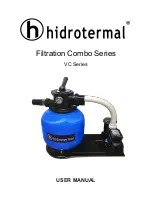
Installation, Operation and Maintenance Manual
Installation, Operation and Maintenance Manual
10
13. Install Icemaker Hookup (optional)
The RO drinking water filtration system can be connected to any standard refrigerator icemaker or ice-
maker/water dispenser. It should never be connected to a commercial type bar icemaker.
Hooking up an icemaker involves connecting a tee with shutoff valve into the blue 3/8” faucet tubing and
routing tubing over to the refrigerator. Hooking up to existing copper tubing is generally not recommended.
If copper tubing must be used, then installation of a small in-line carbon filter at the refrigerator connection
is recommended.
Before turning off the existing tap water supply to the refrigerator icemaker, always shut off the icemaker first
(usually by lifting the lever arm above the bin to the uppermost position). The icemaker should only be turned
on again after the RO system has been drained several times and the tank has a full supply of water.
NOTE: High capacity residential refrigeration icemakers (e.g. Subzero) may require a minimum pressure of
20 psi (138 kPa). In some instances, this unit will not provide 20 psi (138 kPa) or greater pressure. In that
case, a second storage tank will be required. Please call technical services for installation advice.
14. Install Filter Cartridges
A) Remove new filter cartridges from the box.
B) Using tap water (or food grade silicone lubricant or glycerin), wet the o-ring seals to make insertion easier.
C) Line up the cartridge ears, insert cartridge and push into the head until fully seated. Twist the cartridge
1/4 turn to the right (clockwise) to lock into place.
15. Start Up The System
A) Double check that all connections are secure.
B) Turn on feedwater saddle valve and check for leaks. If any leaks are noted, turn off valve and correct
before proceeding. NOTE: If a leak occurs at a “Push-In” fitting, refer to Figure 6.
C) Lift faucet handle and allow tank to drain completely of sanitizing solution. Do not use this water. When
tank is empty, the faucet will steadily drip. This is the rate water is processed by the RO system. Ap-
proximately 2-3 drops per second.
D) Close faucet. Wait at least 4 hours and drain tank again. The water should be discarded as it may con-
tain some disinfectant solution.
E) The system should be ready to use as soon as the tank refills. If any objectionable taste is noticed after
the second tank draining, wait and drain tank the following day. Only when the tank is full should an
icemaker be turned on if one is connected to the system.
NOTE: When the system is first turned on, water may intermittently “spurt” from the air gap module. This is
perfectly normal and is caused by air trapped in the system. This will usually disappear within a short time.
• Before any service is performed on the RO system, always turn off the icemaker valve and the icemaker unit.
Only turn on when the system is operating and the tank is full.
IMPORTANT NOTES
To reduce the risk associated with ingestion of water contaminated with Calcium Hypochlorite sanitizer:
• After installation, sanitizer
must be flushed from the system before first use as directed within the installation
instructions.
To reduce the risk associated with property damage due to water leakage:
•
Ensure all tubing and fittings are secure and free of leaks.
WARNING
CAUTION
16. Installation Troubleshooting
Problem:
Water leaks from opening in air gap module.
Causes:
A) Drain line blocked or drain not drilled through completely.
B) Air lock in air gap outlet.
C) Drain line has loop or is not vertical enough.
Solutions:
A) Check that drain line is clear of obstructions and remove drain saddle fitting to verify that the hole is
drilled through completely.
B) Blow air into air gap outlet using short length of tubing.
C) Shorten tubing so that run is as vertical as possible.
Problem:
Noise in drain (“gurgling” or “dripping” sound)
Cause:
Reject water dripping into standing water in the drain trap.
Solutions:
A) Make sure the 3/8” black tubing from faucet air gap module slopes continuously downward to drain
saddle without loops or low spots.
B) Angle drain piping so reject water runs down side of drainpipe.
C) Change location of drain saddle to horizontal drain pipe or alternate vertical drain pipe farther from the
trap. Properly plug original hole. CAUTION: Make sure drain saddle is always installed above (before)
the trap.
Problem:
System is not producing water.
Cause:
A) Need a minimum of 40 psi (276 kPa) incoming water pressure.
B) Too little or no reject water.
C) Incorrect tank pressure.
Solutions:
A) Increase pressure by adding pressure pump.
B) Disconnect special SFC reject tubing from faucet air gap inlet tubing and check reject flow rate which
should be approximately 175 ml/min.
C) Empty water from tank. Lift tank to verify that it is empty. Adjust pressure to 5-7 psi (34-48 kPa).
Problem:
System is not producing enough water.
Cause:
Incorrect tank pressure.
Solutions:
Empty water from tank. Lift tank to verify that it is empty. Adjust pressure to 5-7 psi (34-48 kPa).
11





























